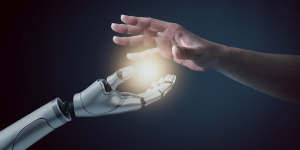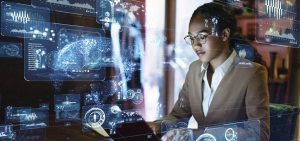AI is typically described as a ‘human-intelligent computer,’ and the characteristic of it is its ability to “learn independently.”
While AI is extremely well known today, many people might still only have some kind of vague notion about it without knowing its fundamental definition or mechanism at all.
This article provides an in-depth analysis of all the way from what “AI” stands for and the history of researching Artificial Intelligence, to learning methodologies like machine learning and deep learning, and how it will transform the future. It also includes business applications in action, providing an overall lesson in AI basics.

What is Artificial Intelligence?
First, let us review what “AI” is, starting with the meaning and definition of the term.
The Origin of the Term “AI”
The term “AI” was first used in 1956. It was proposed by Professor John McCarthy, a computer and cognitive scientist, during the Dartmouth Conference at Dartmouth College in the USA.
What Does “AI” Mean?
AI stands for **Artificial Intelligence**. “Artificial” means something that is “man-made,” and “Intelligence” means “intellect/intelligence.”
The Antonym of Artificial Intelligence
The antonym of AI is **Natural Intelligence** (NI). In Japanese, the word for Natural Intelligence is “natural intelligence,” which implies the intelligence created by nature, i.e., human and animal intelligence.
The Definition of Artificial Intelligence
The Japanese Society for Artificial Intelligence offers the translation of Professor John McCarthy’s words, the originator of the term AI, as the science and engineering of making intelligent machines, especially intelligent computer programs.
However, with the progress of research in AI today, now many researchers define it differently.
Definitions of AI by well-known researchers in Japan are as follows:
| Researcher | Affiliation | Definition |
|---|---|---|
| Hideyuki Nakajima | President, Future University Hakodate | Something with artificially created intelligence, or the science of learning about learning intelligence by attempting to create it. |
| Toyoaki Nishida | Professor, Graduate School of Informatics, Kyoto University | A “mechanism with intelligence” or a “mechanism with a mind.” |
| Riichiro Mizoguchi | Professor, Japan Advanced Institute of Science and Technology | A system that is capable of exhibiting intelligent behavior artificially generated. |
| Makoto Nagao | Professor Emeritus, Kyoto University; former Director, National Diet Library | A system that simulates the operation of a human brain to the best possible extent. |
| Koichi Hori | Professor, Graduate School of Engineering, The University of Tokyo | Artificial intelligence: a new world. |
| Minoru Asada | Professor, Graduate School of Engineering, Osaka University | Since intelligence is not well defined, artificial intelligence is not well defined either. |
| Jin Matsubara | Professor, Future University Hakodate | At last, an artificial intelligence indistinguishable from human beings. |
| Hideaki Takeda | Professor, National Institute of Informatics | Something that has been artificially created as intelligent, or the science of researching how to study intelligence itself by attempting to create it. (Like Nakajima) |
| Takashi Ikegami | Professor, Graduate School of Arts and Sciences, The University of Tokyo | An artificially created system that can produce interactions rich in emotion and humor, like humans or animals, irrespective of physical laws. A system understood discursively in conversation and interaction terms — that is artificial intelligence. |
| Kohei Yamaguchi | Professor, Faculty of Science and Technology, Keio University | A system for constructive imitation, support, and extension of human intellectual behavior. |
| Satoshi Kurihara | Professor, Graduate School of Informatics and Engineering, The University of Electro-Communications | Built by an intelligence engineer, but I believe its intelligence is more superior to humans. |
| Hiroshi Yamakawa | Director, Dwango AI Laboratory | Among computational intelligence, artificial intelligence is when it is either directly or indirectly produced by human beings. |
| Yutaka Matsuo | Associate Professor, Graduate School of Engineering, The University of Tokyo |
While it’s not technically wrong to naively picture “What is AI?” as ‘NI (Natural Intelligence) rebuilt on a computer’ or ‘computer-based human-like intelligence,’ the fact of the matter is that AI lacks a clear definition.
- ◎ Briefly, AI is.
Term coined by computer scientist Professor John McCarthy in 1956 at the Dartmouth Conference.
By the Japanese Society for Artificial Intelligence as *’the science and engineering of making intelligent machines, especially intelligent computer programs.’
A kind of ‘computer with human-like intelligence,’ but without a clear definition.
The History of AI (Artificial Intelligence) Research
Now, AI is increasingly becoming part of human society as an ordinary presence, inscribed in voice assistants like Apple’s “Siri,” iRobot’s vacuuming robot “Roomba,” and SoftBank’s emotion-sensing humanoid robot “Pepper.”
While incredible growth of AI technology in recent history, AI research began actively in the late 1950s. AI evolved gradually with repeated cycles of booms and “AI winters” (periods of stagnation). Following is a summary of AI research history.
The First AI Boom (Late 1950s – 1960s)
The initial AI boom was experienced in the late 1950s to the 1960s, starting with the Dartmouth Conference where the term “AI” was first used.
The background for this boom was the new ability of computers to perform “reasoning” and “exploration” since they were able to reason out solutions to problems given to them. The AI at that time was limited to solving problems with explicit definitions and rules.
When it was understood that it could not handle issues with complicated, interconnected variables in the external world, the AI boom gradually lost its steam. The AI had gone into an “AI winter” (a downturn) by the 1970s.
The Second AI Boom (1980s – 1990s)
The second AI boom arrived during the 1980s to 1990s. Among the primary reasons was the arrival of “Expert Systems,” which made it easier to do “knowledge representation.”
Expert System is a machine intelligence that structures knowledge based on a set of rules, i.e., “If ○ happens, then do ×. Otherwise, do △.” It lacks a method for learning but operates by letting experts foresee all circumstances in advance and make judgments and decisions ready for recall.
The more rules, the more precise, but all of the information had to be entered manually into a format that the computer would understand, limiting practical use to primarily confined areas of information. When everyone realized just how confined the amount of available knowledge was, AI entered into another winter around 1995.
The Third AI Boom (2000s – Present)
The third AI boom started in the 2000s and, up to the first draft of this article in 2019 and through to the current moment, we are yet to emerge out of it.
This boom was propelled by the utilitarian progress of Machine Learning, where AI itself learns from vast amounts of data (big data). Then, in 2006, came Deep Learning, where AI learns the typical features (features) of knowledge on its own, accelerating the boom.
Also, since 2022, “Image Generation AI” with machine learning and deep learning technologies that can generate new images and “ChatGPT” capable of naturally interacting with humans, generating text automatically, summarizing, and gathering information has made AIs that can be used even without technical knowledge spread extensively throughout the world.
The Three Stages of AI
AI is generally described as having three stages: **Artificial Narrow Intelligence (ANI)** ⇒ **Artificial General Intelligence (AGI)** ⇒ **Artificial Super intelligence (ASI)**. But whereas anticipation has mounted with the emergence of ChatGPT, **Artificial General Intelligence (AGI)** and **Artificial Super intelligence (ASI)** are yet to be realized.

Artificial Narrow Intelligence (ANI)
Artificial Narrow Intelligence (ANI) refers to AI with the ability of only demonstrating abilities in specific areas, such as processing numbers, logical processing, and language processing. ANI is found to have the ability of coming up with very precise answers using gigantic amounts of data for a specific field. It is referred to as ANI, with the acronym of Artificial Narrow Intelligence.
Artificial General Intelligence (AGI)
Artificial General Intelligence, or AGI, is AI that is human-like in intelligence and can learn and use its capabilities to deal with situations even in unforeseen situations. It is named AGI, with the abbreviation from the term Artificial General Intelligence.
Artificial Super intelligence (ASI)
Artificial Super intelligence or ASI is, in the name, an AI that learns and understands human intelligence and behavior but surpasses it. It is referred to as ASI, with the acronym for Artificial Super intelligence.
Artificial Super intelligence is defined as being capable of generating ideas beyond what humans can and its capacity to make decisions and solve problems is defined as much superior to that of humans.
Whereas such Artificial Super intelligence shall provide solutions to pressing issues like environmental and social crises, since it would transcend human intellect, arguments about legal frameworks and global governance are considered essential.
Representative AI (Artificial Intelligence) Algorithms
Let us now characterize representative algorithms which are highly important in AI research, otherwise known as the “Big Three of AI”: “**Neural Networks,**” “**Genetic Algorithms,**” and “**Expert Systems.**”
Neural Networks
Neural Networks are artificial intelligence models based on the organization and function of neurons (nerve cells making up the brain of living things). A neuron gets excited if it is supplied with electrical impulses greater than a threshold from other neurons and passes electrical impulses to the neurons that are linked to it. This is the mathematical representation of how neurons collaborate.
A neural network consists of an input layer to receive data, a central layer (hidden layer) to process the weights from the input layer, and an output layer to produce the result. When a human instructor provides the neural network with some example problems and example answers (training signals), the neural network itself becomes proficient in making judgments or inferences regarding matters not explicitly taught to it.
Genetic Algorithms
Genetic Algorithms are Artificial Intelligence based on Darwin’s theory of evolution.
A summary of Darwin’s theory of evolution is as follows:
> Living organisms, based on their environment, allow only superior individuals to give birth, while inferior individuals die. Also, individuals may mutate, sometimes giving rise to superior individuals. If this process is repeated, evolution occurs.
Approaching these “superior people” as “good answers,” Genetic Algorithms attempt to get the best solutions by using evolutionary strategies.
Where Genetic Algorithms are good at is getting the best answer out of an enormous number of possible combinations. They can achieve optimal solutions for combinatorial explosion problems that are difficult to calculate manually.
Expert Systems
Expert Systems are human “thinking” imaged AI. They are distinct from other models of AI because they possess no self-learning feature.
First of all, possible situations and the corresponding responses, judgments, and predictions are gathered from a specific expert. Rules are then formed based on this. Then the system determines which pre-formed situation best matches a user’s inquiry and provides the formed judgment or prediction.
As in the example below, they are particularly active in diagnosing diseases in the medical profession.
Example: Diagnosis by an Expert System
- Question: What is your chief symptom?
Answer: ① Have a fever | ② Have a runny nose | ③ Have a cough
Rule 1: If [have a fever], then conclude as food poisoning.
Rule 2: If [have a runny nose], then judge as a cold.
Rule 3: If [have a cough], then judge as tuberculosis.
As already described, the system gives an advanced diagnosis ready-made according to the user’s response.
While accuracy is improved with more rules, if rules are excessive, their consistency may be difficult to guarantee. Furthermore, if there are gaps in rules or missing essential rules, the judgments cannot be accurately done.
In addition, problems of Expert Systems are that expert assistance is needed in establishing rules, and even when rules are established properly, they cannot reach conclusions outside the domain of the expert.
AI (Artificial Intelligence) Learning Method ①: Machine Learning
Machine Learning is the “learning” of AI. The name carries the implication that “the machine itself learns,” in the way humans do.
That is, the standard is the ability to carry out tasks outside of the purview of what was programmed by the programmer.
Machine Learning can be divided into three broad categories: “Supervised Learning,” “Unsupervised Learning, and “Reinforcement Learning.”
AI (Artificial Intelligence) Learning Method ②: Deep Learning
Deep Learning is a type of machine learning that uses multi-layered neural networks. Given that it has sufficient training data, the neural network is able to automatically learn the features of the data set itself.
The Future of AI: Singularity & Jobs That Might Disappear Due to AI Evolution
Singularity** (Technological Singularity) is a word that began to be employed by AI researchers in the 1980s, referring to the临界点 (critical point) when human beings and artificial intelligence part ways. That is, the point in time when AI at the same level as the human brain is given birth to.
Before long, as we fully embraced the convenience brought on by AI-powered technologies, increasingly often we hear “AI development may steal human jobs.
But the fact that already exists is that still, there exists a huge gap between the NI (Natural Intelligence) which belongs to humans and the AI which appears on computers.
In fact, most of the AIs which are being constructed are problem-specific, and they exist solely to solve one mathematized/models problem.
AI Application in Business
With the learning processes shown up to now, AI now exists in various sectors.
Hereafter is a rundown of AI-capable functions by category. Let’s take a look at how they are being applied.
| Category | Example Application Areas |
|---|---|
| Computer Vision | Image Classification / Image Generation / Object Detection |
| Natural Language Processing | Machine Translation / Language Modeling / Question Answering |
| Healthcare | Medical Image Segmentation |
| Methodology | Distributed Representation (Word Embedding) / Representation Learning |
| Games | Board Games / Video Games |
| Graphs | Node Classification / Link Prediction |
| Speech | Speech Synthesis / Speech Recognition |
| Time Series | Imputation / Time Series Classification |
| Audio | Audio Classification / Music Generation |
| Robotics | Self-Localization / Calibration |
| Music | Music Modeling / Music Information Retrieval |
| Computer Code | Program Synthesis / Dimensionality Reduction |
| Reasoning | Decision Making / Commonsense Reasoning |
| Knowledge Base | Knowledge Graph / Causal Discovery |
| Adversarial | Attack / Defense / Adversarial Text |
| Others | Recommendation / Topic Model |
In business applications, there exist services providing AI itself as a service and services utilizing AI in actual business processes.
Providing AI Itself as a Service
Examples of selling AI itself as a product include image generating services from text input, and ChatGPT, which can answer questions and converse in text form. And also as has appeared in a follow-up case study, there are services that utilize AI image recognition for auto-measurement to recommend best products. In this way, system companies are now creating and marketing various AI systems.
Using AI in Business Operations
This would be the more common application for AI in business.
For instance, in back-office efficiency, incorporation of AI is able to mechanize routine work like accounting processing and schedule adjustments with precision and speed. Further, application of an AI-powered chatbot for customer service facilitates 24/7 operations, liberating human resources from these activities, achieving labor savings and customer benefits.
Moreover, big data collection and analysis is also an AI strength. Through the collection and analysis of data, one can implement customer recommendation functions, discover customer needs that are not evident, and implement these know-how in marketing activities.
Successful Business Use Cases of AI
The following are some successful business applications of AI.
Automatic Measurement App Using AI Image Recognition (UniMate Co., Ltd.)
In the traditional uniform rental business, measurement errors due to human factors occurred too frequently. A big issue was that return and exchange costs, including labor, were too expensive.
To solve this problem, the company developed “AI×R Tailor,” a Progressive Web App (PWA) for AI-based automatic measurement using image recognition. Monster Lab participated starting from the planning stage and executed all the product development processes.
They managed to reduce not only the client’s measurement-related operational cost but also their return costs.
Cashbee Data | Cashback App ‘CASHb’ Image Processing Technology Upgrade

The ‘CASHb’ app is Japan’s first cashback service by Cashbee that collects purchase data from receipts. It creates new possibilities for direct marketing for food, daily necessities, etc., manufacturers of consumer goods.
Cashbee Data, a subsidiary business of Cashbee, acquires and utilizes consumer buying data based on receipt image data received from users, and provides B2C companies with possibilities to use data.
Monster Lab created the image processing technology for improving the reception efficiency of receipt image data and utilizing it as usable data.
Mainichi Broadcasting System (MBS) | Efficiency Improvement in Video Editing Work through AI-based Analysis and Adjustment

Mainichi Broadcasting System (MBS) is a television broadcaster of the Kinki wide-area district.
Monster Lab performed analysis and adjustment using image recognition AI and audio signal processing for 14,215 run-of-the-mill submission videos for MBS’s “39th Suntory 10,000 People’s Ninth” event. By streamlining the first processes in video editing, MBS’s editing work was reduced by 40% compared to last year.
Summary: AI (Artificial Intelligence) Holds the Key to DX
What was that brief overview of the fundamental knowledge on AI, including the definition of the term, definition, development history, and learning process like?
Others might fear or be anxious about AI developing, that is, the fact that it “may surpass human capabilities.” But in today’s increasingly hectic world, it’s not a hyperbole to claim that this is a path that we can no longer avoid.
With the times changing, human society is constantly evolving. It is undeniable that the work brought in by AI will continue to make waves of Digital Transformation (DX) across industries and sectors.
The key is to think positively about how AI can enrich human life. It is better to fully grasp AI and think about the new society.
For companies, in order to reboot existing businesses and create new ones, quickly embedding AI functions and driving DX will be the key to mid- to long-term growth strategy.
Follow us on Facebook for updates and exclusive content! Click here: Each Techs

